 A Novemberish view.
A Novemberish view. We have lots to do outside yet, but in terms of food preparation and preservation, we are pretty much done - and it has been a fruitful year!
It was my first full-scale attempt to put away a good quantity of (mostly) home-grown food for the winter, and while it did involve a fair amount of work, the satisfaction is practically its own reward - although we have already been enjoying a few of the fruits of our labors.... :-)
I have 2 more food preservation tasks left, and then it will be time to rest for a few months - something I'm very much looking forward to after this busy first summer on the homestead!
Here's how things went, for our first season of partially self-sufficient living:
After the wet spring, and hours of back-breaking labor digging a new garden out of the grassy "back 40", our garden was off to a late start, so we didn't really get too overwhelmed until August, when everything seemed to bear fruit at once. For weeks, we were swimming in cucumbers, tomatoes and squash, even though I had tried to exercise restraint when planting the latter. Since we ended up with around 30 tomato plants (including volunteers), that part wasn't so surprising. :-)
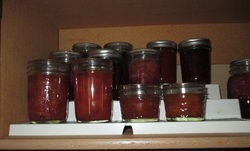 Jams - raspberry, strawberry, & peach.
Jams - raspberry, strawberry, & peach. 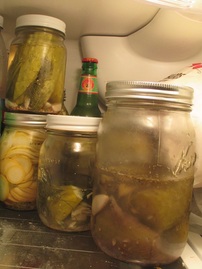 Refrigerator dills - cucumber & squash.
Refrigerator dills - cucumber & squash. I canned about 12 quarts of cucumber pickles - mostly dill, but a few bread & butter - and also made several jars of refrigerator pickles, including one experimental batch of lactic acid fermented dills. Cucumbers tend to get mushy during the fermentation process, but mine were nice and crunchy - for a few weeks. If I make those again I will make sure to eat them up quickly, as they got very soggy later on. I also pickled some non-cucumber items, including 2 pints of watermelon rind pickles, 2 pints of green tomato pickles (just a couple of weeks ago - after picking all the green ones when the first frost hit), some summer squash, and a small jar of jalepeno peppers by special request from my husband.
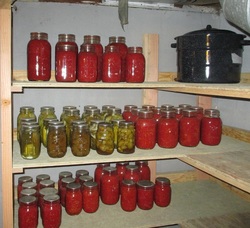 Results of all the canning!
Results of all the canning! When I got tired of canning (and ran out of canning jars), I switched to freezing. Rows of bags of frozen tomatoes, peppers, and shredded zucchini and summer squash line the shelves of the deep freezer. Freezing is also great for miscellaneous items like herbs. I froze quite a bit of dill, which I planted very late, so unfortunately most of the cucumbers were gone by the time it came on strong. I also froze a couple of quarts of whole jalepenos, as well as some whole cayenne peppers, of which we had a really big crop despite planting only 2 plants!
 Frozen tomatoes, peppers, squash,
Frozen tomatoes, peppers, squash, and celery.
Eventually we started picking some stalks, and they were...interesting. They have such a strong celery flavor it nearly burns your eyes when chopping, and they are quite tough. Not woody, but too tough to really eat raw. We tried cooking them, and although it takes quite a while for them to get tender, if cooked in a stew for an hour or two, they are absolutely delicious! The flavor is mellowed a bit, but still VERY strong - you have no doubt what you just got a bite of! And they become very soft and tender.
They will live through some frost, so we left them in the garden for quite a while, and are gradually working on processing them. Since they are so huge and bushy, they don't really fit in the fridge, so I figured I would strip the leaves off, chop them, and freeze them. This turned out to be the perfect method, as freezing seems to tenderize them a bit, so they don't take as long to cook. I also packed the leaves and really thin stalks in large freezer bags and froze those as well - they add a great flavor to stocks!
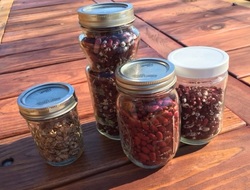 Pinto, kidney, & Jacob's Cattle beans,
Pinto, kidney, & Jacob's Cattle beans, Besides finishing up the celery harvest, I only have 2 remaining preservation tasks. One is to do something with the refrigerator drawer full of eggplants which suddenly set in September and left us with loads of little round purple beauties when frost hit. We already made moussaka and various other eggplant dishes, which barely made a dent in our supply. However, I found an interesting looking recipe for Italian pickled eggplant (which doesn't require canning, thank goodness), so I will be trying that this week.
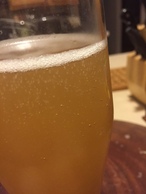 Super-bubbly hard cider
Super-bubbly hard cider from last fall.
Being a hard-cider lover, I thought I'd try my hand at that as a method of preserving this beautiful apple juice. I tried several different batches using different fermentation methods last fall, and each was very different but delicious in its own way. This fall I'm trying yet another method - starting with a culture of fermented ginger bug. We'll see how it goes, but judging from past experience, it's sure to be delicious.
Cheers to a cozy, warm house, and lots of delicious, nutritious food that we grew ourselves! :-)
Rose.

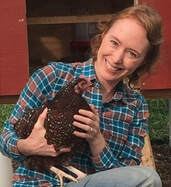

 RSS Feed
RSS Feed